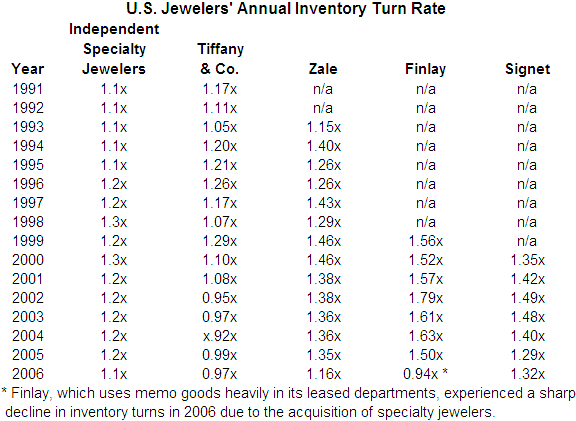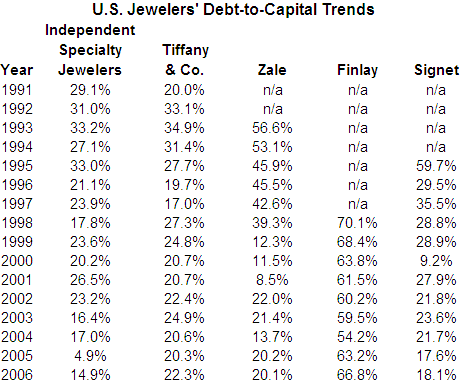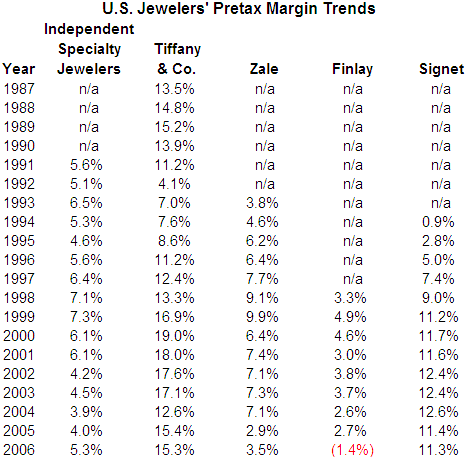IDEX Online Research: Financial Pressures Threaten Jewelers’ Profits
March 20, 08
In a perfect world, jewelers would generate pretax margins of 7-9 percent, turn their inventories at least three times per year and have roughly $1 in debt for every $2 of equity.
Unfortunately, we don’t live in a perfect world. Jewelers’ pretax margins are well below the optimum level, their inventory turns at an unacceptably low rate and their debt levels are too low to allow them to leverage profits adequately.
Jewelry Economic Operating Model Unusual
When compared to other retailing economic operating models, jewelers’ financial models are almost off the bell curve. It is no surprise that they have difficulty borrowing money from banks. Not only do the banks not understand jewelers’ financial models, but the industry’s financial model in today’s world will not generate profit levels sufficient to entice investors’ capital.
Retailing “norms” for certain key financial ratios include the following:
- Pretax margin of at least 6-7 percent, ranging up to 10 percent.
- Inventory turns of three or more times per year.
- A debt load of $1 for every $2 of equity (owners’ equity on the balance sheet). Expressed as the more common financial measure “debt to total capital,” this would yield a 33 percent debt-to-capital ratio, since capital includes both owners’ equity and debt.
- Pretax margin below 5 percent for most independent and some chain jewelers.
- Inventory turns of just over one time per year.
- A debt load of $1 for every $3-4 of equity, or a debt-to-capital ratio near 20-25 percent.
Most U.S. retail merchants generate pretax margins of 6 percent to as high as 8 percent. While this is down from the days when a 10 percent pretax margin was the norm, today’s pretax margin levels are still high enough to borrow capital and generate a profit above the cost of capital.
Unfortunately, independent specialty jewelers’ pretax margins have been below 5 percent for four of the past five years, and dipped below 4 percent during one of those years, as the table below illustrates. That is simply not an acceptable level to pay for capital used to finance the business. Because banks are unwilling to lend on such thin pretax margins, and because Wall Street investors can get much better returns on their capital in other industries, jewelers use their vendors as lenders. They delay payments, they obtain goods on consignment and they ask for monetary help with advertising, markdowns, and other business related expenses.
|
|
Inventory Turn Far Too Low
Most fashion retailers turn their inventories at least three times per year. With four seasons of fashion, some merchants strive to increase that turn to four or more times per year; however, a three-times turn is more or less the norm. Jewelry, which is a fashion item (except among very high end jewelers), turns at about 1.1 times per year among both independent and chain jewelers.
If memo goods are included in the inventory turn calculation, the typical jeweler – both chain and independents – turns their inventory at 0.7x-0.8 times per year. In other words, they turn their inventory about every 15-17 months, an unacceptably low rate for providers of capital. From an investor’s viewpoint, that is inefficient use of capital.

Source: Company Reports & Jewelers of America
With an inventory turn of only one or less times per year, it is difficult for jewelers to have new fresh merchandise in their stores. U.S. shoppers visit a jewelry store only about three times per year. If they don’t see any new, fresh, exciting merchandise, they won’t be back.
In contrast, other fashion retailers have goods for each of the four seasons. New, exciting goods are constantly arriving in their stores. The merchandise that doesn’t sell is either marked down, returned to the vendor, or sold off to third party liquidators. Even if the head buying merchant thinks that the company’s seasonal buys are great looking, the customer is the final arbiter: if shoppers snatch up the goods, that’s great; if not, they are moved out so fresh goods can be brought in.
Debt Levels Low
On the face of it, low debt levels should make merchants feel good: they owe only a little money. But a good merchant knows how to make money using “OPM” – “Other Peoples’ Money.” If they can borrow money from a bank to buy goods that will generate a profit above the cost of the capital from the bank, they are using capital efficiently.
Some chain jewelers have debt levels far above the rule of thumb of $1 in debt for every $2 of equity. Some chains have reversed those numbers – so far successfully – to $2 (or more) of debt for every $1 of equity. Finlay Enterprises, the operator of leased jewelry departments in major U.S. jewelry stores, had $3 in debt for every $1 in equity for its quarter ended October 2007. On the other hand, Tiffany & Company, the world renowned jeweler, had about $1 in debt for $4 in equity at the end of its October 2007 quarter, a low level by any measure. These debt levels are about in line with each company’s historic levels, and do not represent a deviation from their long term norm.
We believe that jewelry industry debt levels at the retail could rise safely, provided merchants could generate higher pretax margins and show that they can leverage borrowed funds – generate a profit notably above the cost of capital.
Unfortunately, because retail jewelers generate sub-optimum financial returns, they are forced to rely on their vendors for financing via memo goods, extended payment terms and markdown money.

Source: Company Reports & Jewelers of America
The Bottom Line: The Financial Model Must Be Updated
For decades, jewelers have operated with the current financial model. We argue that it won’t work in today’s retail environment where returns on capital are the key determinant of who gets growth capital and who doesn’t.
Two factors will bring change to the financial model that jewelers currently use:
- Banks, other lenders and Wall Street will demand an efficient financial model that generates an acceptable return on capital.
- Online jewelers are re-writing the financial operating model for the industry.
There are financial management systems available for even the smallest independent jewelers in the U.S. If they embrace those models, they may be able to muddle through the current slowdown, and, at the same time, build a springboard for growth when the economy rebounds. Those who continue to do business by the seat-of-their-pants won’t be around at the end of the current business cycle.
